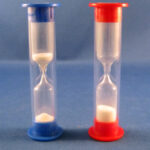How do Colors Combine in your Eye?
Subject: Physics
Grade Level(s): Grade 8, High School, Grade 3, Grade 7
Topic: Light & Optics
Big Idea(s):
- Construct a yellow and blue disk that, when spun, looks like it is white.
- Construct different disks that show color addition when spun.
- Explain the colors perceived when different colors are seen in quick succession.
- Generate a self-contained written report of experimental findings.
What you need:
- Cardboard
- String
- Paints or Colored Paper
Grouping:
Vocabulary Words:
Time Needed:
Summary:
Just as the eye perceives additive colors when colored dots are placed close
together (as in the newspaper), color addition can be demonstrated by presenting colors in rapid succession. A disk with re ions of color will appear when spun, to be the addition of those colors.
Learning Goals / Objectives:
- To investigate the additive properties of light using colored disks.
Background
This experiment is appropriate for students at all levels. Students should have completed activities on Color Addition and Colored Objects before completing this lab.
Techniques
Colors used in this activity should be of similar brightness. A brighter color can overpower a weaker color and produce an unexpected result (Bright red + weak cyan will not give white. It may give pink or red instead.)
Students may want to try combinations of more than two colors.
Anticipatory Set:
How does the eye perceive colors when two different colors are presented in rapid succession?
Instructions / Activities:
- Construct a small disk (1-2 inches in diameter) out of cardboard or other suitable material.
- Paint (or use colored paper) one half blue and the other half yellow, as shown in Figure 26. Use a paper punch to put two holes in the disk, as shown.

-
Place a string through the holes and twist the ends of the string so that, when you pull outward on the string, the disk spins.
- As your eye receives blue and yellow light in rapid succession, what color do you observe?
- Make disks using other colors. Describe the results in your report.
Assessment:
Teacher’s Discretion
Wrap-up / Closure:
Teacher’s Discretion
These materials are contained in a kit in our Library!
Tags: Grade 3, Grade 7, Grade 8, High School
Categories: Physics


